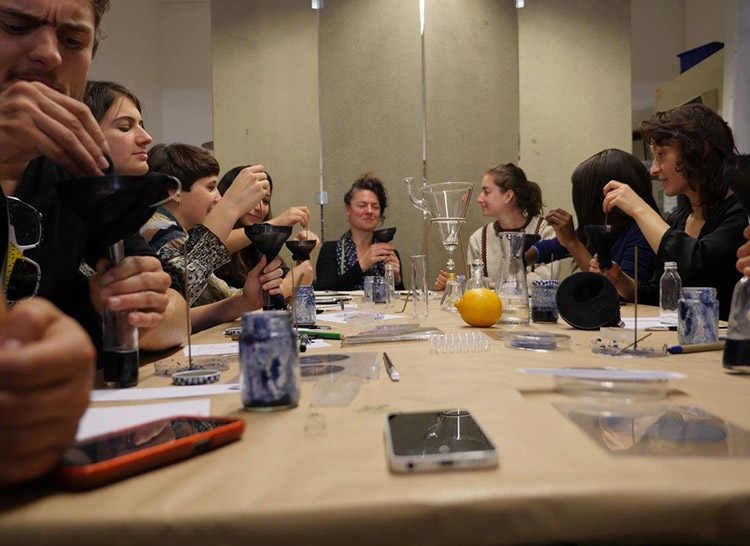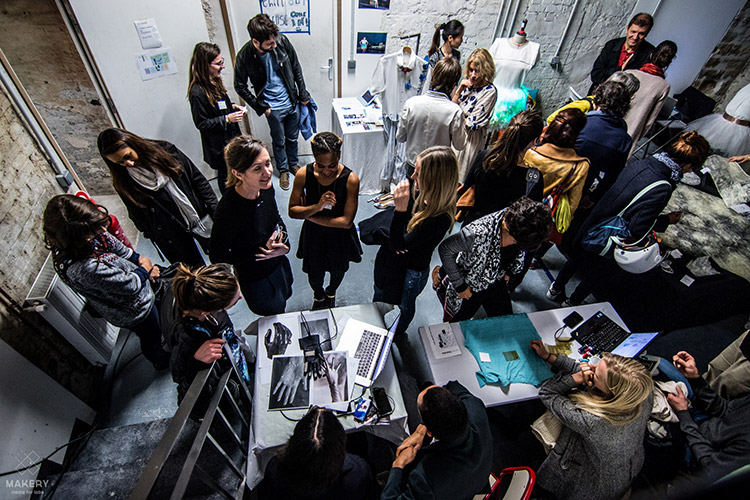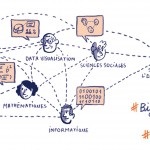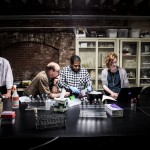Thomas Landrain: “La Paillasse or alternative scientific research”
Published 2 August 2016 by Annick Rivoire
Thomas Landrain heads La Paillasse, the biohacklab that has disrupted scientific research. Founded in 2011 in a squat, the lab has since 2014 migrated to central Paris, operates with 10 permanent staff, and initiates collaborative projects for open innovation. Interview.
At 31, Thomas Landrain has given up on his promising career in biology research. That’s because the co-founder and president of La Paillasse fights his battle in many fields—political, economical, scientific. It’s a battle for open science, rather unusual in the world of DIYbio. Less open in education than in research, the model of La Paillasse, which went from a suburban squat to an 800 m2 space in central Paris, with its 10 permanent staff and collaborative research projects, is envied and studied around the world. This interview—which started off as an informal discussion while Landrain was participating in his first Fablab Festival in Toulouse last May—has been enriched by e-mail, over the course of constant cross-Atlantic trips by this busy pioneer.
This year, La Paillasse is leading its first open and collaborative research project on cancer, Epidemium, with Roche laboratories. Is this a reorientation of the biohacklab project?
The backbone of La Paillasse, is first and foremost life science. But we want to ask new questions, not limit ourselves to a “wet” biotech approach, explore data and software, enable the creation of new interfaces. La Paillasse was created five years ago in a squat in Vitry, and today we’re better equipped than my graduate research institute. In three years, it was a quantic leap that brought us from the 50 m2 basement of a rundown building in an industrial area to a 800 m2 lab in central Paris, which offers much broader diversity.
We are an open community research lab that covers everything from textiles to electronics, from meditation to hardware… Inside this same space, we invite people who have nothing to do with biology, like the “drone and bacteria” team. La Paillasse is above all a hub for interfacing, an anchored location for multiple communities. It’s a research lab where anybody can base their activity, from start-ups to artists… Besides creating spaces for physical labs, La Paillasse’s new business model enables the most horizontal access possible to a lab, to diverse forms of creativity and science programs that are about imagining scientific research that is alternative to institutional research.
Our first POC [Proof of Concept, phase just before prototyping], realized in partnership with Roche laboratories, consisted of showing that we could bring a large community to volunteer and collaborate on producing work and open tools that are useful to scientific research on a topic as complex as the epidemiology of cancer. The partnership with Roche was ideal. While La Paillasse wanted to express a new vision of scientific research based on the flexibility of open data, Roche as a world leader in cancer research could explore new ecosystems and work methodologies, and all this without exclusive rights to the work provided by the community! All production for Epidemium is de facto open source and open data, the true cement of our open and participative approach. Epidemium 1.0 lasted six months, and concluded with a very high quality of projects, a huge quantity of work distributed within a large and very diverse community, more than 300 people in the Paris region alone.

Is this a new form of “user generated content”, which has worked so well for YouTube and Facebook, applied to scientific research?
We’re far from YouTube, because here we create knowledge that is standardized and validated by the scientific community, whereas YouTube tries to highlight individual and performative creativity. La Paillasse must be an interface—our role is to guarantee both the rights and ethics of our communities, to see to it that our partners find what they’re looking for, while allowing the community to develop freely. La Paillasse has initiated this cultural change, before the conventional labs risk doing so in a direction that might not be in the interest of the community in the long term!

When we organized the launch of DIYBio Europe in 2012 in Paris, we brought together about 50 people from a dozen countries in order to create a big collaborative network to tackle bigger challenges together. This didn’t work, because we were naïve enough to believe that young local communities with different modalities and visions could work together naturally. In reality, there were significant differences in cultures and passions. For example, we were the only biohackerspace whose mission wasn’t mainly oriented toward education and making science accessible, but rather on developing original technical projects. Actually, we emerged in reaction to the hermetic nature of the academic world, with the goal of creating an alternative model for the science laboratory, based on the fundamental values of sharing, transparency and citizen counter-power. Today, La Paillasse in Paris has 10 full-time staff on its team and a network of bio-scavengers to gather material for the hyper low-cost lab, where 90% of the equipment is always second-hand.
Has La Paillasse pioneered a new model?
La Paillasse Saône and Hackuarium (in Switzerland) are close to us and share our vision. Many other labs ask to join a sort of “Paillasse” network. The model is also a hit in Canada, where a space inspired by La Paillasse is due to open soon in Ottawa. In October, we’ll also experiment with a new genre, designing and building a Paillasse Océan in Saint-Brieuc, and open laboratory entirely dedicated to ocean exploration and the intelligent use of marine resources. However, before launching the project of a big network, we want to consolidate and promote this Paillasse model, which is still quite singular in the landscape of third-spaces.
The boundaries between fablab and biohacklab are sometimes blurry. Where do you place DIYbio and fablabs?
The origins of these two movements are quite different. Fablabs express an ideal of technological development, whereas DIYbio leans more toward free expression around life science, often artistic and provocative.
“We start from well before the maker movement, when biology doesn’t have equipment and consumables that are as cheap as for mechanics and electronics.”
However, there is clearly a rise in critical mass, biofabrication is currently a strong trend within fablabs, and that’s a good thing. But La Paillasse doesn’t define itself as a fablab, our objective is to create new work environments to enable new forms of scientific research as a source for developing open technologies. Public research could have a lot to gain from our approach. Thierry Mandon, secretary of state in charge of higher education and research, came by to see us. We were very pleasantly surprised by his openness of mind.
While dialogue is possible with the National Research Agency (ANR), public funding could go toward distributed research. We’re already leading a common science program with the Pasteur Institute. Axelle Lemaire, secretary of state for digital media, is ready to sponsor the initiative.
How can you guarantee the quality of open and collaborative research? What are the rules for scientific validation?
For the Epidemium project, we had two committees, a scientific committee and an ethics committee independent from both La Paillasse and Roche, comprising representatives of associations of patients, doctors, researchers (including Field medal Cédric Villani) and entrepreneurs. In order to finish the program and benefit from Epidemium’s visibility, the projects of the community must be validated by both committees. Moreover, since 2011 La Paillasse operates on in-house rules and a collaborative code of ethics. Since January, we’re also equipped and authorized to practice genetic manipulations for synthetic biology projects. The bio-security rules that we apply to our residents are the same as those that are applied to academic research laboratories.
Could you elaborate on La Paillasse’s new business model?
Since April 2016, we have 10 people working full-time at La Paillasse (we started paying the first members of the team in February 2015) and an operating budget (for 2015) of 700,000€. For now we have no grant support, because we feel that it would hinder us from experimenting radically with new business models for research. We regularly reinvent ourselves… We recently decided to disrupt the model that we had been using since we arrived in Paris two years ago, which consisted of making La Paillasse a coworking lab space. It works financially, but we created two incompatibilities with our vision of the open and community laboratory—a derivative form of clientelism and a selection bias based on the capacity of a person or project to be self-financed in order to access the lab, when the primary resource of most of our residents is not their wallet but their brain and their time.

So we decided to create a program for free residencies in order to allow even more diverse profiles to express their creative potential—scientists, makers, coders, designers, entrepreneurs, artists… These residencies (for between 30 and 50 people for 6 to 12 months) will allow them to invest fully in their project, accompanied by La Paillasse. In exchange, these people will give us five days of their time every month to work on collaborative research projects, whether it’s prospective research funded by partners or selling creative prototyping. Since May, we went from 50 residents to 20. We still have some people paying for space, but they’re now a minority.
“We have returned to the roots of La Paillasse, an open and free lab where we can explore new creative interfaces thanks to the diversity of our community.”
So La Paillasse positions itself as THE open research lab?
It’s a big issue for us. Six months ago we began a collaboration with the Network Science Institute at Northeastern University in Boston, to experiment with ways of managing masses of people working over a network. I went to see the best in the world according to the analysis of groups’ success, and we set up a common research group that works with the latest tools (Rocket.chat, an open source Slack, videoconferencing…). It’s always incredible to witness the efficiency of open science communities and how fast we make progress. We observe and analyze, among other things, the behavior and successes of participants in the iGEM synthetic biology competition, which has been attracting more than 15,000 participants for the past 10 years. We do this in order to develop new hypotheses for optimizing collaborative work in the context of large-scale scientific collaborations, and to apply them to develop our own open research programs. We have become what we wanted to be, by freeing ourselves from the conventional voices of research.
More on La Paillasse


